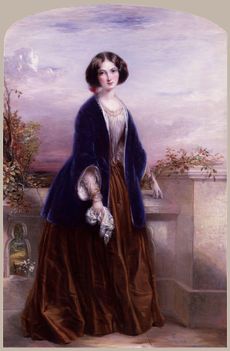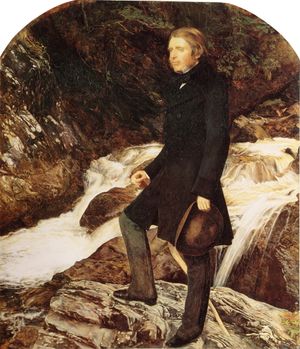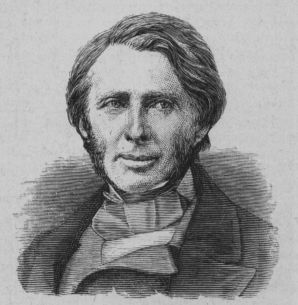جون رسكن
جون رسكن John Ruskin | |
|---|---|
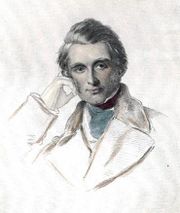 نقش ملون لجون رسكن | |
| وُلِد | 8 فبراير 1819 54 هنتر ستريت، ميدان برنزويك، لندن، إنگلترة |
| توفي | 10 يناير 1900 برانتوود، كنسيتون، إنگلترة |
| الوظيفة | كاتب، ناقد فني، رسام، رسام ألوان مائية، مفكر اجتماعي، رجل بر |
| الجنسية | إنگليزي |
| الجامعة الأم | كنيسة المسيح، جامعة أكسفورد |
| الفترة | العصر الڤكتوري |
| أبرز الأعمال | المصورون الحديثون 5 أجزاء (1843–60)، المصابيح الهندسة المعمارية السبعة (1849)، حجارة البندقية 3 أجزاء (1851–53)، حتى هذه النهاية (1860، 1862)، Fors Clavigera (1871–84)، Praeterita 3 أجزاء (1885–89). |
| الزوج | يوفميا تشارلمرز گراي (1828–1897) (فسخ العقد) |
جون رَسكِن John Ruskin (و. 8 فبراير 1819- ت. 20 يناير 1900)، هو كاتب وناقد فني ومصلح اجتماعي إنگليزي صاحب خبرة طويلة في إظهار ونشر الفن القوطي، وتوطيد دعائم الحس الفني في العصر الڤكتوري.
حياته
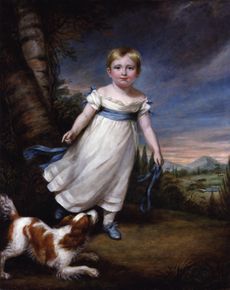
ولد رَسكِن في لندن في عائلة برجوازية، كان والده تاجراً غنياً أمَّن له تربية وتعليماً رفيعاً، وكان يرافقه إلى المعارض الفنية، مما شجع ميوله إلى الرسم والقراءة وخاصة الكتابات الاتباعية (الكلاسيكية) والإبداعية (الرومنسية) التي أصبحت، إلى جانب قراءته للكتاب المقدس وتجواله الواسع في أوربا، أساس ثقافته الأدبية والفنية.
بدأ رَسكِن الكتابة حول موضوعات هي من صلب اهتمامه كالطبيعة والشعر وفن العمارة في مجلة التاريخ الطبيعي بين عامي 1834-1836، وحول شعر "الهندسة المعمارية" في المجلة المعمارية بين عامي 1837-1838، وكتب أيضاً قصائد قلد فيها بايرون وقصصاً للمناسبات. دخل جامعة أكسفورد في السابعة عشر من عمره وحصل في أثناء دراسته على جائزة نيودگت للشعر عام 1839 مما مكنه البدء بجمع رسوم أبرز المصورين الإنگليز في ذلك الوقت. وعند انتهاء دراسته عام 1842 قام برحلة إلى إيطاليا كتب في أثنائها الجزء الأول من المصورون الحديثون عام 1843 دفاعاً عن المصورين الإنكليز وفي مقدمتهم الفنان ترنر، معالجاً موضوع صدق الحس الفني في تصوير الطبيعة.
قام رَسكِن بزيارة لشمالي إيطاليا في عام 1845 وأُخِذ بجمال طبيعتها ودرس عن كثب أوابدها المعمارية ومنحوتاتها القروسطية مما شكل لديه انطباعاً لا يمحى، وكانت الصور القلمية التي رسمها في هذه الرحلة من أفضل ما أنتج. ثم كتب الجزء الثاني من المصورون الحديثون (1846)، ومصابيح هندسة العمارة السبعة عام 1849، وحجارة البندقية بين عامي 1851- 1853 في ثلاثة أجزاء. وتلا ذلك الجزءان الثالث والرابع من المصورون الحديثون 1856.
كان هذا النتاج الغزير في فترة زواج رَسكِن من يوفيميا گراي، التي كان قد أهداها مؤلفه ملك النهر الذهبي عام 1851 ونُشر بعد عشر سنوات من كتابته، إلا أنها حصلت على الطلاق عام 1854 وتزوجت صديقه الفنان جون ميليه. عمل بعد ذلك في التعليم في كلية العمال، وفي إنشاء متحف أكسفورد للتاريخ الطبيعي، وفي تصنيف أعمال الفنان تُرنر في صالة العرض الوطنية، وفي تشجيع فنانين وأدباء مثل دانته روزتي ، وفي إلقاء المحاضرات في طول البلاد وعرضها لتنمية الحس الفني العام. إلا أنه كان ناقداً خشناً بدأت آراؤه في السياسة والاقتصاد تطغى على فنه، كما في خطابه "الاقتصاد السياسي للفن" عام (1857)، وكذلك تمرده على القيم الموروثة عبر تربيته الدينية البرجوازية، فكتب حول توزيع الثروة وقانون العرض والطلب وعلاقة الرأسمال باليد العاملة، وهاجم ميل وغيره في كتابه حتى هذه النهاية عام (1860).
ما قبل الرفائيلية
أسس جون إڤرست ميلايس، وليام هولمان هنت، ودانته گابريل روزتي، أخوية ما قبل الرفائيلية عام 1848. التزمت ما قبل الرفائيلية بالمذهب الطبيعي - "الرسم من الطبيعة فقط"،[4] تصوير الطبيعة بتفاصيلها الدقيقة، تأثراً برسكن.
راسكن الناقد والمصلح الاجتماعي: حتى هذه النهاية
المصورون الحديثون ج5 (1860) [5]
كتب رَسكِن أيضاً مجموعة مقالات مثيرة للجدل حول لا إنسانية الأوضاع المادية والاجتماعية للطبقة العاملة أثارت حفيظة الكثيرين ممن حوله. وفي "مقالات حول الاقتصاد السياسي" بين عامي 1862- 1863 و"أخلاقيات التراب" عام 1866 أعلن الحرب على روح عصره، الذي تميز بالمادية والأنانية، في محاولة للرجوع إلى القيم والأخلاق. وفي خضم هذا النشاط السياسي والاجتماعي نشر الجزء الخامس من المصورون الحديثون 1860 منهياً بذلك شهادته الفنية على عصره.
روز لا توش
تدهورت صحة رَسكِن النفسية ومع ذلك صار أستاذاً للفنون الجميلة في جامعة أكسفورد بدءاً من عام 1869 ولعقد من الزمن، متابعاً اهتمامه بأوضاع العمال. ولما كانت الرسائل الوسيلة المفضلة للتعبير لديه فقد كتب مجموعة منها إلى العمال "الزمن والمد" عام (1867)، وأخرى بعنوانها المحيّر "فورس كلاڤيگيرا"، الذي كان شعاراً لجمعية القديس جورج التي أسسها رَسكِن بهدف الإصلاح الاقتصادي والاجتماعي الشامل، وكانت استمراراً لتحديه أرباب العمل والأوضاع الراهنة.
عانى رَسكِن من الانهيارات العصبية المتكررة ومن خيبة الأمل في العلاقات العاطفية والاجتماعية، إلا أنه كان الناقد الفني والاجتماعي الأبرز، وكان فاعلاً في آخرين ممن عاصروه أمثال شو وبروست. ومع تدهور صحته إلى الحضيض في آخر سنوات حياته، ومع التناقض والغموض وانعدام التوازن في تفكيره فقد كتب أفضل إنتاجه في ما يشبه السيرة الذاتية "أحداث ماضية" بين عامي 1885-1889 اعتماداً على يومياته. وتوفي بعد صمت دام عقداً من الزمن في بلدة كونستن في منطقة البحيرات الإنگليزية.
ذكراه
النظرية والنقد

المنتصف: رسكن في منتصف العمر، كأستاذ سلاد في كلية الفنون جامعة أكسفورد (1869–1879). من كتاب 1879.
أسفل: جون رسكن شيخاً، رسم فردريك هولير. 1894 .
نقد الفن والتصميم

الحفظ التاريخي
Modern Painters V (1860) [6]
جدل
رسومات ترنر الجنسية
Until 2005, biographies of both J. M. W. Turner and Ruskin had claimed that in 1858 Ruskin burned bundles of erotic paintings and drawings by Turner to protect Turner's posthumous reputation. Ruskin's friend Ralph Nicholson Wornum, who was Keeper of the National Gallery was said to have colluded in the alleged destruction of Turner's works. In 2005, these works, which form part of the Turner Bequest held at Tate Britain, were re-appraised by Turner Curator Ian Warrell, who concluded that Ruskin and Wornum did not destroy them.[7][8]
القانون العام لتوازن الأعمال وسؤال حول حقوق التأليف
Ruskin is supposed to have commented upon the relationship of price and quality in manufactured goods, and this assertion has been called the Common Law of Business Balance. "There is absolutely nothing in the world that some man cannot make a little worse and sell a little cheaper; and the people who consider price only are this man's lawful prey," is the statement attributed to Ruskin. Although this statement has been repeatedly attributed to Ruskin, Ruskin's authorship of this statement has been disputed.
الجنسانية
Ruskin's sexuality has led to much speculation and critical comment. His one marriage, to Effie Gray, was annulled after six years because of non-consummation.
تعريفات
- Pathetic fallacy: Ruskin coined this term in Modern Painters III (1856) to describe the ascription of human emotions to inanimate objects and impersonal natural forces, as in "Nature must be gladsome when I was so happy" (Charlotte Brontë, Jane Eyre).[9]
أعمال مختارة
أعمال رسكن
- قصائد (كتبها 1835–46، مجمعة 1850) (أعمال 2)
- شعر في العمارة (serialised The Architectural Magazine 1837–38؛ نشر ككتاب 1893) (أعمال 1)
- خطابات لزميل الجامعة (كتبها 1840–45، نشرت 1894) (أعمال 1)
- The King of the Golden River, or the Black Brothers. A Legend of Stiria (كتبه 1841؛ نشره 1850) (أعمال 1)
- الحديثون (5 vols.) (1843–60) (أعمال 3–7)
- Vol. I (1843) (Parts I and II) Of General Principles and Of Truth (Works 3)
- Vol. II (1846) (Part III) Of the Imaginative and Theoretic Faculties (Works 4)
- Vol. III (1856) (Part IV) Of Many Things (Works 5)
- Vol. IV (1856) (Part V) Mountain Beauty (Works 6)
- Vol. V (1860) (Part VI) Of Leaf Beauty (Part VII) Of Cloud Beauty (Part VIII) Of Ideas of Relation (1) Of Invention Formal (Part IX) Of Ideas of Relation (2) Of Invention Spiritual (Works 7)
- مصابيح هندسة العمارة السبعة (1849) (أعمال 8)
- حجارة البندقية (3 ج) (1851–53)
- ج.1 The Foundations (1851) (أعمال 9)
- Vol. II. قصص البحار (1853) (Works 10) – containing the chapter "طبيعة الفن القوطي"
- Vol. III. The Fall (1853) (Works 11)
- Notes on the Construction of Sheepfolds (1851) (Works 12)
- Pre-Raphaelitism (1851) (Works 12)
- Letters to the Times on the Pre-Raphaelite Artists (1851, 1854) (Works 12)
- Lectures on Architecture and Painting (Edinburgh, 1853) (1854) (Works 12)
- Academy Notes (Annual Reviews of the June Royal Academy Exhibitions) (1855–1859, 1875) (Works 14)
- The Harbours of England (1856) (Works 13)
- The Elements of Drawing, in Three Letters to Beginners (1857) (Works 15)
- ’A Joy Forever’ and Its Price in the Market: being the substance (with additions) of two lectures on The Political Economy of Art (1857, 1880) (Works 16)
- The Two Paths: being Lectures on Art, and Its Application to Decoration and Manufacture, Delivered in 1858–9 (1859) (Works 16)
- The Elements of Perspective, Arranged for the Use of Schools and Intended to be Read in Connection with the First Three Books of Euclid (1859) (Works 15)
- Unto This Last: Four Essays on the First Principles of Political Economy (serialised Cornhill Magazine 1860, book 1862) (Works 17)
- Munera Pulveris: Six Essays on the Elements of Political Economy (serialised Fraser's Magazine 1862–63, book 1872) (Works 17)
- The Cestus of Aglaia (serialised Art Journal 1864-64, incorporated (revised) in On the Old Road (1882) (Works 19)
- Sesame and Lilies: Two Lectures delivered at Manchester in 1864 (1865) (i.e. ‘Of Queen’s Gardens’ and ‘Of King’s Treasuries’ to which was added, in a later edition of 1871, ‘The Mystery of Life and Its Arts’) (Works 18)
- The Ethics of the Dust: Ten Lectures to Little Housewives on the Elements of Crystallisation (1866) (Works 18)
- The Crown of Wild Olive: Three Lectures on Work, Traffic and War (1866) (to a later edition was added a fourth lecture (delivered 1869), called ‘The Future of England’) (1866) (Works 18)
- Time and Tide, by Weare and Tyne: Twenty-five Letters to a Working Man of Sunderland on the Laws of Work (1867) (Works 17)
- The Queen of the Air: A Study of the Greek Myths of Cloud and Storm (1869) (Works 19)
- Lectures on Art, Delivered before the University of Oxford in Hilary Term, 1870 (Works 20)
- Aratra Pentelici: Six Lectures on the Elements of Sculpture Given before the University of Oxford in Michaelmas Term, 1870 (1872) (Works 20)
- Lectures on Landscape, Delivered at Oxford in [Lent term| Lent Term], 1871 (1898) (“Works” 22)
- Fors Clavigera: Letters to the Workmen and Labourers of Great Britain (1871–1884) (“Works” 27–29) (originally collected in 8 vols., vols. 1–7 covering annually 1871–1877, and vol. 8, Letters 85–96, covering 1878–84)
- Volume I. Letters 1–36 (1871–3) (“Works” 27)
- Volume II. Letters 37–72 (1874–76) (“Works” 28)
- Volume III. Letters 73–96 (1877–84) (“Works” 29)
- The Eagle's Nest: Ten Lectures on the Relation of Natural Science to Art, Given before the University of Oxford in Lent Term, 1872 (1872) (Works 22)
- Ariadne Florentina': Six Lectures on Wood and Metal Engraving, with Appendix, Given before the University of Oxford, in Michaelmas Term, 1872 (1876) (Works 22)
- Love's Meinie: Lectures on Greek and English Birds (1873–1881) (Works 25)
- Val d’Arno: Ten Lectures on the Tuscan Art, directly antecedent to the Florentine Year of Victories, given before the University of Oxford in Michaelmas Term, 1873 (1874) (Works 23)
- The Aesthetic and Mathematic School of Art in Florence: Lectures Given before the University of Oxford in Michaelmas Term, 1874 (first published 1906) (Works 23)
- Mornings in Florence: Simple Studies of Christian Art, for English Travellers (1875–77) (Works 23)
- Deucalion: Collected Studies of the Lapse of Waves, and Life of Stones (1875–83) (Works 26)
- Proserpina: Studies of Wayside Flowers, While the Air was Yet Pure Among the Alps, and in the Scotland and England Which My Father Knew (1875–86) (Works 25)
- Bibliotheca Pastorum (i.e. ‘Shepherd’s Library’, consisting ofmultiple volumes) (ed. John Ruskin) (1876–88) (Works 31–32)
- Laws of Fésole: A Familiar Treatise on the Elementary Principles and Practice of Drawing and Painting as Determined by the Tuscan Masters (arranaged for the use of schools) (1877–78) (Works 15)
- St Mark's Rest (1877–84, book 1884) (Works 24)
- Fiction, Fair and Foul (serialised Nineteenth Century 1880–81, incorporated in On the Old Road (1885)) (Works 34)
- The Bible of Amiens (the first part of Our Fathers Have Told Us) (1880–85) (Works 33)
- The Art of England: Lectures Given in Oxford, During his Second Tenure of the Slade Professorship (delivered 1883, book 1884) (Works 33)
- The Storm-Cloud of the Nineteenth Century: Two Lectures Delivered at the London Institution, February 4 and 11 1884 (1884) (Works 34)
- The Pleasures of England: Lectures Given in Oxford, During his Second Tenure of the Slade Professorship (delivered 1884, published 1884–85) (Works 33)
- Præterita: Outlines of Scenes and Thoughts Perhaps Worthy of Memory in My Past Life (3 vols.) (1885–1889) (Works 35)
- Dilecta: Correspondence, Diary Notes, and Extracts from Books, Illustrating ‘Praeterita’ (1886, 1887, 1900) (Works 35)
يوميات وخطابات مختارة
- The Diaries of John Ruskin eds. Joan Evans and John Howard Whitehouse (Clarendon Press, 1956–59)
- The Brantwood Diary of John Ruskin ed. Helen Gill Viljoen (Yale University Press, 1971)
- A Tour of the Lakes in Cumbria. John Ruskin's Diary for 1830 eds. Van Akin Burd and James S. Dearden (Scolar, 1990)
- The Winnington Letters: John Ruskin‟s correspondence with Margaret Alexis Bell and the children at Winnington Hall ed. Van Akin Burd (Harvard University Press, 1969)
- The Ruskin Family Letters: The Correspondence of John James Ruskin, his wife, and their son John, 1801–1843 ed. Van Akin Burd (2 vols.) (Cornell University Press, 1973)
- The Correspondence of John Ruskin and Charles Eliot Norton ed. John Lewis Bradley and Ian Ousby (Cambridge University Pres, 1987)
- The Correspondence of Thomas Carlyle and John Ruskin ed. George Allen Cate (Standford University Press, 1982)
- John Ruskin's Correspondence with Joan Severn: Sense and Nonsense Letters ed. Rachel Dickinson (Legenda, 2008)
أعداد مختارة لرسكن لا تزال تحت الطباعة
- Praeterita [Ruskin's autobiography] ed. Francis O' Gorman (Oxford University Press, 2012)
- Unto this Last: Four essays on the First Principles of Political Economy intro. Andrew Hill (Pallas Athene, 2010)
- Unto This Last And Other Writings ed. Clive Wilmer (Penguin, 1986)
- Fors Clavigera: Letters to the Workmen and Labourers of Great Britain ed. Dinah Birch (Edinburgh University Press, 1999)
- The Storm-Cloud of the Nineteenth-Century preface by Clive Wilmer and intro. Peter Brimblecombe (Pallas Athene, 2012)
- The Nature of Gothic (Pallas Athene, 2011) [facsimile reprint of Morris's Kelmscott Edition with essays by Robert Hewison and Tony Pinkney]
- Selected Writings ed. Dinah Birch (Oxford University Press, 2009)
- Selected Writings (originally Ruskin Today) ed. Kenneth Clark (Penguin, 1964 and later impressions)
- The Genius of John Ruskin: Selections from his Writings ed. John D. Rosenberg (George Allen and Unwin, 1963)
قراءات إضافية
- Helen Gill Viljoen Ruskin‟s Scottish Heritage: A Prelude (University of Illinois Press, 1956)
- John D. Rosenberg The Darkening Glass: A Portrait of Ruskin’s Genius (Columbia UP, 1961; Routledge and Kegan Paul, 1963)
- Robert Hewison John Ruskin: The Argument of the Eye (Thames and Hudson, 1976)
- Sarah Quill Ruskin's Venice: The Stones Revisited (Ashgate, 2000)
- Kevin Jackson The Worlds of John Ruskin (Pallas Athene, 2010)
- Carroll Quigley (1966), Tragedy and Hope: A History Of The World In Our Time (GSG & Assoc)
- كان الكتاب هو لراسكين. « حتى الرجل الأخير » شرعت في قراءة الكتاب، ولم أستطع أن أتوقف؛ فلقد استحوذ عليّ. استغرقت الرحلة من جوهانسبرج إلى دربان أربعًا وعشرين ساعة. كان المساء قد أقبل عند وصول القطار إلى دربان. ولم أستطع النوم طوال تلك الليلة. فقد قررت أن أغير حياتي وفقًا للأفكار الواردة في الكتاب. كان ذلك هو أول كتاب أقرؤه لراسكين. ففي أيام دراستي لم أقرأ أية كتب تقريبًا بخلاف الكتب الدراسية، وبعد أن انغمست في الحياة العملية لم يتسن لي إلا اليسير من الوقت للقراءة. لذلك لا أستطيع أن أدعي أن لديّ معرفة واسعة بالكتب، ومع ذلك، أعتقد أنني لم أخسر الكثير نتيجة لهذا القيد الذي فُرض عليّ، بل على العكس، يمكن القول بأن قراءتي المحدودة تلك قد مكنتني من استيعاب ما قرأته بالكامل. وكان ضمن تلك الذي تسبب في إحداث تحول فوري وعملي في حياتي. ،« حتى الرجل الأخير » الكتب كتاب .Sarvodaya « الخير للجميع » وقد ترجمته فيما بعد إلى اللغة الجوجراتية تحت اسم أؤمن بأنني اكتشفت بعض معتقداتي الدفينة في كتاب راسكين العظيم. ولهذا السبب استحوذ عليّ الكتاب وجعلني أغير من حياتي. إن الشاعر هو الذي يستطيع أن يثير أجمل المشاعر الكامنة في داخل الإنسان. وتأثير الشعر على من يتلقونه يختلف من شخص إلى آخر فكل إنسان يختلف عن الآخر في تلقيه له. هي: « حتى الرجل الأخير » أرى أن التعاليم التي ينادي بها كتاب ١) منفعة الفرد تكمن في منفعة الجميع. ) ٢) لا تقل قيمة عمل الحلاق عن قيمة عمل المحامي لأن الجميع يحق لهم أن يكسبوا ) قوتهم من العمل. ٣) إن حياة العمل، أي حياة الفلاح والحرفي، هي الحياة التي تستحق العيش. ) وقد عرفت أول هذه التعاليم، أما ثانيها فقد أدركته على نحو يسير، لكنني لم أواجه ثالثها قط. وقد أوضح لي الكتاب أن التعليم الأول يحوي بين طياته التعليم الثاني والتعليم الثالث معًا. واستيقظت قبالة الفجر، متأهبًا لتنفيذ هذه المبادى---كتاب غاندي سيرة ذاتية قصة تجاربي ص400
مراجع عن راسكن
- W. G. Collingwood (1893) The Life of John Ruskin (2 vols.) (Methuen)[10]
- E. T. Cook (1911) The Life of John Ruskin (2 vols.) (George Allen)[11]
- Derrick Leon (1949) Ruskin: The Great Victorian (Routledge & Kegan Paul)
- Tim Hilton (1985) John Ruskin: The Early Years (Yale University Press)
- Tim Hilton (2000) John Ruskin: The Later Years (Yale University Press)
- John Batchelor (2000) John Ruskin: No Wealth But Life (Chatto & Windus)
- Francis O’Gorman (1999) John Ruskin (Pocket Biographies) (Sutton Publishing Ltd.)
- Robert Hewison (2007) John Ruskin (Oxford University Press)
- James S. Dearden (2004), John Ruskin (Shire Publications)
انظر أيضاً
- John Henry Devereux
- رسكن، نبراسكا
- Ruskin's diggers in Ferry Hinksey (1874)
- Ruskin's Ride, a bridleway in Oxford
- ترنتن، ميزوري حيث توجد أول كلية لرسكن في الولايات المتحدة
- Charles Augustus Howell
- البيت الإنگليزي
المصادر
- ^ In the preface of the 1871 edition of Sesame and Lilies Ruskin mentions three figures from literary history with whom he feels an affinity: Guido Guinicelli, Marmontel and Dean Swift; see John Ruskin, Sesame and lilies: three lectures, Smith, Elder, & Co., 1871, p. xxviii.
- ^ Euphemia ('Effie') Chalmers (née Gray), Lady Millais, National Portrait Gallery
- ^ Ruskin and Millais at Glenfinlas, The Burlington Magazine, Vol. 138, No. 1117, pages 228–234, April 1996. (Accessed via JSTOR, UK.)
- ^ Cook and Wedderburn 12.357n.
- ^ Cook and Wedderburn 7.422–423.
- ^ Cook and Wedderburn 17.34
- ^ The Guardian report on the discovery of Turner's drawings. Also see Warrell "Exploring the 'Dark Side': Ruskin and the Problem of Turner's Erotica", British Art Journal, vol. IV, no. 1, Spring 2003, pp.15–46.
- ^ New York Times article: "No Bonfire Devoured J.M.W. Turner's Erotica" 13 January 2005
- ^ Modern Painters III (see Part VI, "Of Many Things", c. XII, "Of the Paethetic Fallacy") see Works 5.201–220.
- ^ The Life of John Ruskin sixth edition (1905)
- ^ The Life of John Ruskin vol. 1 of the second edition (1912) The Life of John Ruskin vol. 2 of the second edition (1912)
وصلات خارجية
- مكتبة ومركز أبحاث رسكن
- Brantwood, Ruskin's Lake District home on Coniston Water
- Ruskin’s Guild of St George Collection at Millennium Galleries, Sheffield
- Ruskin at Walkley an online reconstruction of Ruskin’s original St. George’s Museum, in Walkley, Sheffield
- The Ruskin Society
- Ruskin Museum, Coniston
- The Elements of Drawing: John Ruskin’s Teaching Collection at Oxford
- The Eighth Lamp, Ruskin Studies Today. Ruskin journal
- John Ruskin on In Our Time at the BBC. (listen now)
- أعمال من John Ruskin في مشروع گوتنبرگ
- Birmingham Museums & Art Gallery's online biography and gallery. Retrieved 2010-10-19
- UK Museum, Library and Archive collections relating to Ruskin at Cornucopia.org.uk. Retrieved
- John Ruskin texts in the Baldwin Library of Historical Children's Literature Digital Collection. Retrieved 2010-10-19
- Sheffield City Council's Ruskin Libraries and Archives. Retrieved 2010-10-19
- Liverpool Museums audio files on Ruskin
- Archival material relating to جون رسكن listed at the UK National Register of Archives
- پورتريهات John Ruskin في معرض الپورتريه الوطني، لندن
- صفحات تستخدم جدول كاتب بمتغيرات غير معروفة
- Pages using authority control with unknown parameters
- منظرون معماريون
- فنانون حركة الفنون والحرف
- كتاب عمارة إنگليز
- أكاديميون إنگليز
- مسيحيون إنگليز
- بيئيون إنگليز
- كتاب مقالات إنگليز
- فلاسفة إنگليز
- نقاد فن إنگليز
- علماء اجتماع مسيحيون
- علماء أصداف
- أشخاص مرتبطون بأخوية ما قبل الرفائيلية
- خريجو جامعة أكسفورد
- أشخاص مرتبطون بجامعة أنگليا رسكن
- فنانون من لندن
- إنگليز-إسكتلنديون
- خريجو كينگز كولدج لندن
- مواليد 1819
- وفيات 1900
- إنگليز من القرن 19
- فلاسفة القرن 19
- رسامو ألوان مائية إنگليز
